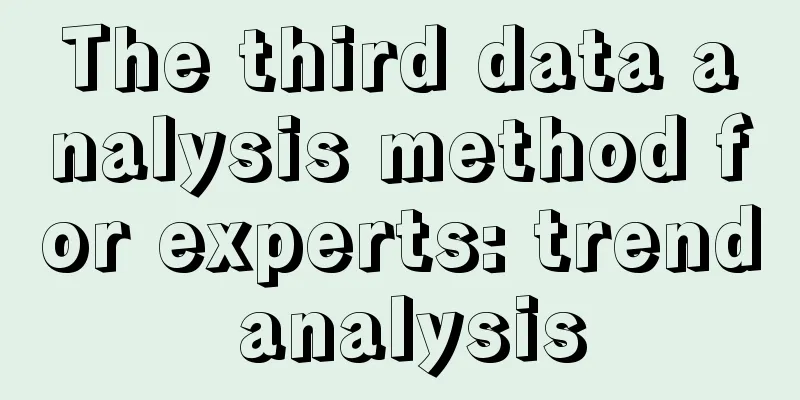The third data analysis method for experts: trend analysis

What is the most commonly used method in data analysis? Of course, it is trend analysis. As long as it is related to data, almost everyone uses it all the time. Many students heard: "What? There is such a method? Why didn't I realize it!" Today we will explain it systematically. Please listen to the question The following chart shows the sales performance trend from the 1st to the 8th of this month. Answer the questions based on the chart: 【True or false】No. 8’s performance is better than No. 7’s, right? 【True or false】No. 7 has better performance than No. 6, right? 【True or false】No. 6’s performance is better than No. 5’s, right? [True or false] So this month's performance is going to be good, right? Think for one second. It is estimated that many students can blurt out the answer in less than one second. 1. Trend Analysis MethodThe previous question is an intuitive experience of analyzing through performance trend charts. Many students blurt out four "right, right, right, right". Yes, the basic principle of trend analysis is so simple that almost everyone can use it. The first step is to clarify whether an indicator is positive/negative. For example, in this question, sales performance is a positive indicator, and everyone certainly hopes to sell as much as possible. Therefore, if the positive indicator is getting bigger day by day, it means the trend is positive, and if it is getting smaller day by day, it means the trend is not good. The second step is to collect data and observe the trend of indicators. Because we have already made it clear that "the higher the sales index, the better", we only need to observe the data. We see that it is getting better day by day, so we can conclude that the sales trend is improving. Below we can analyze why sales are so good. It's simple, 90% of online articles and data analysis courses teach this. However, this answer is wrong. Because they don’t consider what industry or product the sales performance is. The sales of different industries and products will show different sales trends within a certain period of time. For example, sales of food, drink, entertainment and entertainment are often concentrated on weekends, and will show cyclical fluctuations in units of weeks. For example, 3C electronic products are the hottest when new products are launched, and then they will show signs of gradual decline. When the sales trend adds a time dimension, regularity will appear. So, the first three questions of this question are all "yes, yes, yes", and the fourth question is "not sure". If you want to be sure, you need to do at least two more steps based on the two steps you have already done. The third step is to establish trend benchmarks and establish judgment criteria. There are two ways to set a benchmark. If you are familiar with the industry, you can directly draw a general trend chart based on the characteristics of the industry. If you are not familiar with it, you can extend the time forward and look at the trend of the previous few weeks. Of course, if you want to observe the trend, it is best to draw three charts of year-on-year, month-on-month, and three-year comparison. This is the most accurate way to avoid the impact of short-term fluctuations to the greatest extent (by the way, this is also why when people make reports, they often have three indicators of year-on-year, month-on-month, and three-year comparison, and divide the statistics into three calibers of daily, weekly, and monthly, just to avoid short-term influences and observe whether the trend is normal). The fourth step is to fit the current data into the benchmark and draw conclusions. If we have already established a benchmark pattern and apply the data from the title at the beginning of the article, we will immediately have a different interpretation (as shown in the figure below). So why is it called "trend analysis method" instead of "I draw a line graph, high is good, low is bad". Because even if you draw a line graph, you have to follow the rules step by step to avoid making wrong judgments. This is the difference between the method and playing around. As we will see below, playing around often leads to problems. 2. Advantages of trend analysisThe biggest advantage of trend analysis is that it saves trouble! Because it does not require any theoretical basis, any professional knowledge, or a lot of data. As long as there is a result data, whether it is positive or negative, it can directly make a judgment. Therefore, it is the first to be summarized among all data analysis methods, and it has been used for more than 20 years. You have to know that 20 years ago, the digital systems of enterprises were still in a chaotic state. Professional managers at that time wanted to make judgments, but they did not have as much detailed data for analysis as they do now, so they could only stick to a few result data such as profits, costs, and sales. Therefore, you can only stick to the curve trend. You will find that professional managers born in the 1960s and 1970s, and data people before 1985, are particularly sensitive to the curve trend, and they particularly like to look at data such as the trend of three years and the trend of the past 12 months. The second benefit: direct! Taking sales as an example, are many auxiliary activities, such as marketing activities and new customer acquisition, really useful for sales? There is no need for complex funnel analysis. Just take a look at the trend and you will see the effect immediately. The simpler the method, the more reliable it is when evaluating the results! (As shown in the figure below). The third benefit: built-in standards. The trend of the curve itself can be used as a criterion for judging the quality of an indicator. In addition to the natural cycle/life cycle type criteria mentioned above, the degree of rise and fall can also be used as a criterion for judgment, which saves a lot of time in finding criteria. (As shown in the figure below). This method is still very useful today. Although we have the conditions to do AB test, funnel, and multi-dimensional cross analysis, we are asked to do this every day, every hour, and every moment. Just try it. Not to mention that doing data will be exhausting, in order to do so many analyses, the business will be delayed online, the progress of APP development will be slowed down, and the activities will be held one by one to do tracking and testing. Ask the business whether they will do it. Therefore, a large number of conventional analyses still rely on daily and weekly data to do trend analysis to meet the needs. Moreover, the data changes every day, every hour, and every moment, making the business people nervous and clamoring for in-depth analysis, only to find out afterwards that nothing happened: there are many such cases! 3. Disadvantages of trend analysisOne of the shortcomings: being nervous. The "three people make a tiger" effect is very common in trend analysis. The specific example is shown in the figure below. People tend to be sensitive to sudden and huge, consecutive, and different from the previous consecutive events, but tend to ignore bigger problems. The second shortcoming: confounding factors. Trend analysis cannot handle confounding factors when observing causal effects. When multiple factors are superimposed, it is impossible to distinguish the real key influencing factors. The third shortcoming: misuse and abuse. Note that trend analysis has its prerequisites. It can only be used when the indicator is a result indicator with a clear positive/negative judgment. Other scenarios, such as proportions and ratio indicators such as activity rate and consumption rate, cannot be directly applied. For proportion/ratio indicators, you must first see which of the numerator and denominator causes the change. For example: the number of user registrations and page views, which are not clear positive or negative, are not suitable for use. At least they must be linked to the conversion rate. As for what was said at the beginning of the article: it seems that high is good and low is bad, which is a typical abuse. Shortcoming 4: Lack of insight. The most classic scene is stock speculation. Just look at the picture and you will understand it at a glance. Because in essence, trends are driven by the reasons behind them. To see trends, we need to look at the reasons behind them, rather than simply looking at the results and taking them for granted. This is why we developed methods such as AB test, funnel chart, multi-dimensional cross-comparison, etc. We need simple methods to make decisions quickly and easily, and we also need more complex methods to get to the bottom of the problem. 4 What other ancestral methods are there? Some methods are traditional techniques in the field of data analysis. For example, multi-dimensional cross-analysis, if it is 2D, is the matrix method, if it is 3D or above, is the cutting comparison method. Yes, these various "underlying logics" and "core ideas" that are hyped up in online articles are actually not magical at all. They are all methods generated based on specific scenarios, data limitations, and business needs. |
<<: What exactly are the benefits that Xiaohong Bookstore is broadcasting?
>>: Zhong Shanshan blasts live streaming sales: How many people will this offend?
Recommend
Brand Tragedy
Brand is the most distinctive and recognizable sym...
The essence of marketing is to discover needs and create value
This article discusses the topic of "what is ...
Auspicious rabbits welcome the spring, and the atmosphere of the New Year depends on them
Major brands started their Spring Festival marketi...
Not just wholesale! 1688's ambition for the C-end is revealed
In recent years, 1688, a traditional wholesale pla...
Tik Tok’s “new god” is “out of fashion” in just half a month?
This article mainly introduces the "deificati...
Should I learn domestic e-commerce or cross-border e-commerce? Detailed analysis
Many businesses want to start their own business f...
What is Shopee's preferred seller? What are the tips for becoming a preferred seller?
After you open a shop on Shopee, if all indicators...
Douyin e-commerce launched its own "Taobao" clone
This article deeply discusses the strategic layout...
Does Shopee need to set up overseas warehouses? Is it necessary?
Shopee's products are sold overseas. If they a...
Should I choose individual or business for Amazon tax? How to get Amazon tax verification?
When selling on Amazon, sellers need to choose the...
We are unwilling to accept the substitution and are ridiculed for the price increase. How should domestic products be priced appropriately?
In the tide of the consumer market, prices reflect...
How does Shopee refund the price difference to customers? What should I do if the customer asks for a refund of the price difference?
After some Shopee customers bought a certain produ...
The industry’s first “store visiting regulations” have been released. Is store visiting by internet celebrities a good business?
We are attracted by bloggers' store visits vid...
"WeChat" merges with "TikTok", the first 1 billion-level traffic dividend is coming in 2023...
With the advent of the new data era, what changes ...
How to decorate a shop using Shopify? Decoration tutorial introduction
Shopify is a one-stop business platform. Merchants...









